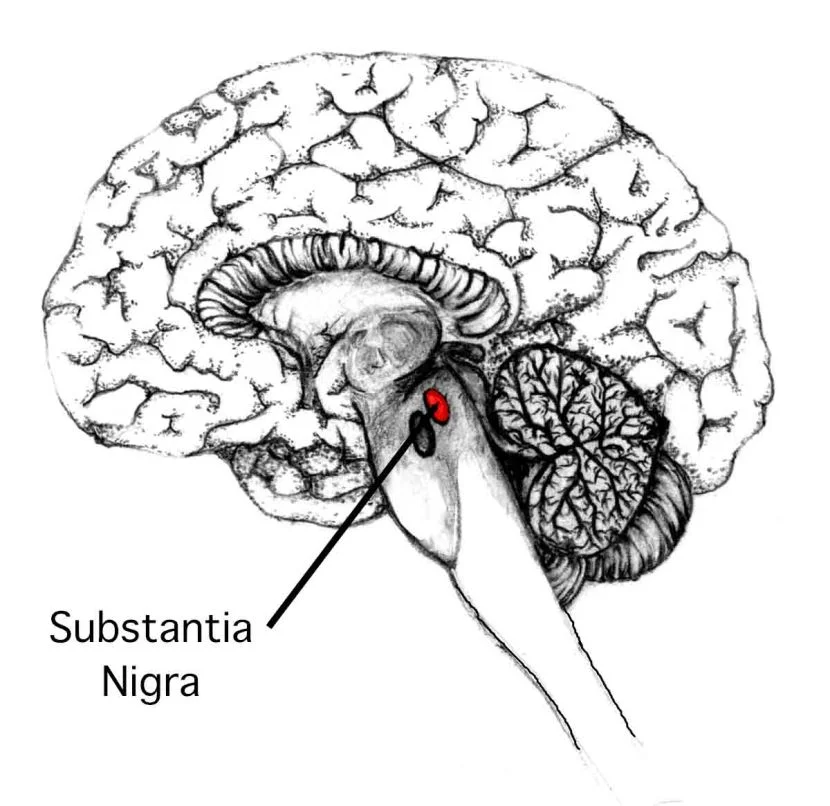Answer: The Braak hypothesis argues that the onset of sporadic Parkinson's disease is due to the entry and propagation of a pathogenic foreign invader.
Parkinson's disease (PD) is an incurable neurodegenerative disorder. Parkinson's disease causes motor symptoms such as a resting tremor and difficulty with initiating movement. These symptoms are the results of a loss of dopaminergic innervation in the dorsal striatum (caudate and putamen), which causes an imbalance in the direct and indirect outputs.
The cell bodies in the substantia nigra are lost in PD. These cells produce dopamine. Before being lost, many of them contain proteinous inclusions within the cell bodies. These misshapen aggregates of proteins are composed of alpha synuclein. The presence of several aggregates is called Lewy body pathology.
The Braak hypothesis is offered to explain the onset of spontaneous Parkinson's disease (Staging of brain pathology related to sporadic Parkinson's disease.) According to the Braak hypothesis, some unidentified pathogen such as a virus or bacterium is inhaled and ingested. That pathogen triggers a response that results in Lewy pathology that infects the neurons of the nasal cavity as well as the neurons in the stomach. The Braak hypothesis offers a prion disease-like explanation for the onset of Parkinson's disease. The support for this is given by the digestive difficulties observed in patients with Parkinson's (Gastrointestinal dysfunction in Parkinson's disease) and the changes in the olfactory system (Olfaction in Parkinson's disease and related disorders.)
In the Braak hypothesis, these infected neurons then send the misshapen proteins towards the brain. The infected neurons of the nasal cavity spread the pathology into the brain via the olfactory nerve (cranial nerve I). The neurons in the gut spread using the vagus nerve (cranial nerve X).
In the Braak hypothesis, as the disease progresses, there are six stages. Each stage represents the major site of Lewy body pathology, starting from the enteric nervous system moving into the brain. In stages 1 and 2, pathology is seen in the hindbrain. In the middle stages, stages 3 and 4, when the midbrain is affected, the motor symptoms of Parkinson’s disease become observable. In the final stage, the neocortex is completely infected with Lewy body pathology.
One of the criticisms of the Braak hypothesis is that not all patients with Parkinson's disease follow the clinical symptoms that is predicted from the site of Lewy pathology. Another criticism stems from the observation that the symptoms of Parkinson's disease may not correlate with the Braak staging and the predominant site of Lewy pathology (A Critical Evaluation of The Braak Staging Scheme for Parkinson’s Disease)
In support of the Braak hypothesis is the REM sleep behavior disorder that is found in patients with Parkinson’s disease. Changes in REM sleep are observed to precede the onset of motor symptoms in PD (Pathophysiology of REM sleep behaviour disorder and relevance to neurodegenerative disease.) The regulation of REM sleep is mostly controlled by hindbrain structures. These structures may be influenced by alpha synuclein buildup, resulting in a change in their normal physiological function. The Lewy body accumulation in these regions could lead to the REM sleep behavior disorder.
The Braak hypothesis offers the hope that if the pathology were detected in its early stages, then the spread of the Lewy bodies into the higher areas of the brain can be prevented. For this therapy to be effective,it would require that we figure out how to prevent the spread of the pathology in the first place. It also depends on being able to detect pathology in the enteric nervous system before further disease spread.
Early Braak stages correspond to synucleinopathy in the brain stem and peripheral nervous system. It is only in mid Braak stages when substantia nigra pars compacta begins to show accumulation of synuclein and the subsequent loss of cells that have previously been used as the marker for Parkinson’s disease.
Other regions of the brain that are observed with synucleinopathies include the locus coeruleus, the Raphe nucleus, and the dorsal motor nucleus of the vagus nerve. These regions have all been implicated as vulnerable in the Braak hypothesis.
The Braak hypothesis considers the appearance of Lewy bodies as harmful. Although these alpha synuclein deposits are associated with several neurodegenerative diseases such as Parkinson’s disease and head damage, it is not entirely clear that the Lewy bodies cause the damage. In some cases, they may be protective. By accumulating all of the harmful misshaped protein in one place, the Lewy bodies prevent them for acting at other sites (Alpha-synuclein phosphorylation controls neurotoxicity and inclusion formation in a Drosophila model of Parkinson disease.)










